Andhra Pradesh BIEAP AP Inter 1st Year Accountancy Study Material 8th Lesson Cash Book Textbook Questions and Answers.
AP Inter 1st Year Accountancy Study Material 8th Lesson Cash Book
Essay Type Questions
Question 1.
Describe the meaning and importance of the cash book.
Answer:
Among the entire subsidiary books, cash book is one of the important books. In this book we record cash receipts and cash payments. The main objective of cash book is to know the balance of cash at any given time. The person who maintains cash book is known as cashier. Business transactions are mainly two kinds.
- Cash Transactions
- Credit Transactions
All cash transactions are two types :
- Cash receipts
- Cash payments
Cash receipts should be recorded on debit side and cash payments are on the credit side. Generally cash book shows debit balance, because a business unit cannot pay more than its receipts.
Question 2.
Briefly explain the different types of cash books.
Answer:
The form of the cash book depends on the need, nature and scope of activities of a business firm.
They are as follows :
1) Simple cash book
2) Double column cash book
i) With cash and discount columns
ii) With bank and discount columns
3) Triple column cash book
4) Analytical petty cash book
1) Simple Cash Book: The simple cash book is maintained by small business concern. Only cash transactions are recorded in this book. Cash receipts are to be recorded on the debit side and cash payments are on credit side. After entering all the transactions, the balance is ascertained like other accounts.
2) Double Column Cash Book:
a) Cash Book with Cash and Discount Columns: The transactions pertaining to cash and cash discounts are also recorded. To record the discount involved in any transactions one additional column on both sides of the cash book is provided. Discount column on the debit side should be named as discount allowed, and on the credit side discount received. They should not be balanced.
b) Cash Book with Bank and Discount Columns : Modern business organisations carry their transactions in the form of cheques through banks. The receipts and payments of the business are made through cheques. They maintain bank column in the cash book. The traders deposit money and cheques into bank account and make payments by cheques. The traders’ deposit through bank is having advantages of safety and convenience.
3) Triple Column Cash Book: This book also known as cash book with cash discount and bank columns. It contains three columns on both the sides. Three column cash book is used by big trading organisations, to record large number of cash and bank transactions of different nature.
4) Analytical Petty Cash Book: In large scale business organisation cash is paid and received through banks, but every day the organisation has to pay various small payments. It is not possible to pay small payments through cheques and enter in the cash book. Hence all petty payments of the business are recorded in a separate cash book which is called a Petty Cash Book.
![]()
Question 3.
Write the importance of Triple column cash book and draw its pro forma.
Answer:
Triple column cash book contains three columns on both sides (debit and credit) in addition to date, particulars and L.F columns. Three column cash book is very useful to the big trading organisations for the following reasons.
- It helps to record cash Receipts and also Receipts through cheques.
- It is useful to record Cash Payments and also Payments by Cheques.
- It helps to record large number of cash and bank transactions of different nature.
- It is useful to record Contra Entries.

Question 4.
Explain the important points to be followed in the preparation of three column cash book.
Answer:
The following points are to be noted carefully while preparing three column cash book.
- Opening cash and bank balances are recorded on the debit side of the cash and bank column as “To Balance b/d” in the particulars column.
- If the overdraft is given as opening bank balance, it should be recorded on the credit side of Bank column.
- All cash receipts should be recorded on the debit side cash column and cash payments are recorded in the cash column on the credit side.
- If any cheque is received from customers and if it was not deposited in the bank on the same day, it should be debited to cash column.
- If cheque is received and sent to bank on the same day, it should be debited to bank column.
- Any payment made through cheque, should be credited to bank column on the credit side.
- If discount amounts are involved either in cash or in bank transactions, discount allowed should be recorded on the debit side and discount received should be recorded on the credit side in the discount column.
- If the cheques sent to bank for collection are dishonoured, it should be recorded in the bank column on debit side.
- The transaction which is passed on both sides of the cash book is called ‘Contra Entry’. While opening bank a/c, cash deposited in bank, cash withdrawn from bank for personal use and cheque received on one day but deposited on another day. Contra entries will appear on both sides. It is denoted by “C”.
Short Answer Questions
Question 1.
Explain the advantages of cash book.
Answer:
Advantages of Cash Book:
- It helps to know the amount of cash received and the amount of cash paid by the Business Unit.
- It gives the Cash and Bank balances of a business unit at any given period.
- Mistakes or Fraud can be detected by verifying the closing balance of cash book with the actual amount of cash in hand.
- As cash book acts as Cash A/c, preparation of a separate Cash A/c (ledger) is not required.
![]()
Question 2.
Give the characteristics of cash book.
Answer:
Characteristics of Cash Book :
- Cash book is a Subsidiary Book.
- It records only Cash Transactions.
- Cash book serves as Cash Account.
- It records cash receipts on the debit side and cash payments on the credit side.
- Cash book will show Debit Balance only.
Very Short Answer Questions
Question 1.
Cash Discount (Mar. ’17 – T.S.)
Answer:
It is given for prompt and early payment. If a debtor pays the amount to the creditor on or before the due date, he may receive discount in the form of cash. It is known as cash discount. It is discount received for the debtor and discount allowed for the creditor. The discount column is maintained on both sides of the cash book.
Question 2.
Discount Allowed
Answer:
Discount given or allowed by the creditor is known as discount allowed. It is a loss for the ‘ creditor. This was allowed to the debtor for prompt payment.
![]()
Question 3.
Discount Received
Answer:
If a debtor pays the amount on or before the due date, he may receive discount in the form of cash. It is gain for the debtor. It is called discount received.
Question 4.
Contra entry (Mar. 2019 ; May ’17 – T.S.) (Mar. 2018 – A.P.)
Answer:
The transaction which is recorded on both sides of Triple column cash book i.e. Cash and Bank on the opposite sides is called contra entry. Contra means opposite side. It should be denoted by “C” in the L.F column on both sides of Triple Column Cash Book.
Question 5.
Imprest System
Answer:
In this system petty cash payments for a period is estimated and that amount is given to the petty cashier as advance. The cashier makes payments from this amount and records them in petty cash book. At the end of a particular period the petty cashier submits petty cash book to the Head Cashier. The Head Cashier scrutinizes the petty payments and issues a fresh cheque equal to the amount of petty expenses paid. This system of book keeping is called Imprest System.
Problems
Question 1.
Prepare süaple cash book as on 1.1.2014 from the following particulars:

Answer:
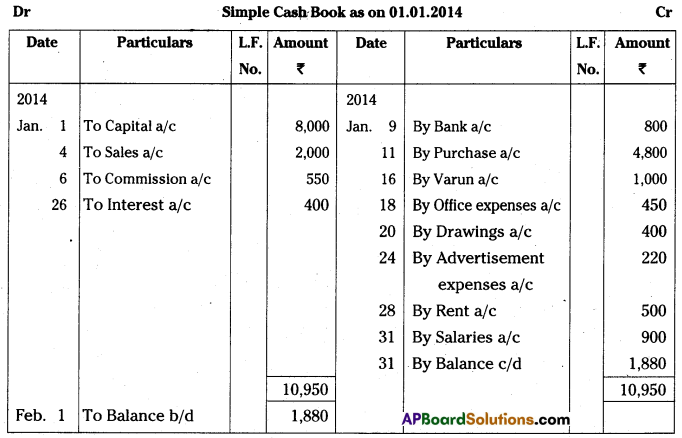
![]()
Question 2.
Enter the following transactions in single column cash book of Farma traders

Answer:

Question 3.
Prepare Simple Cash Book as on 31.3.2014.

Answer:

Question 4.
Record following transactions in Two Column Cash book as on 31.1.2014:
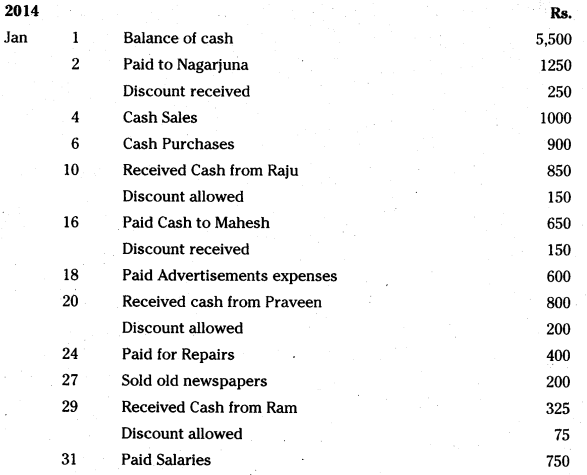
Answer:

Question 5.
Prepare Double Column Cash Book with Cash and Discount Columns:

Answer:
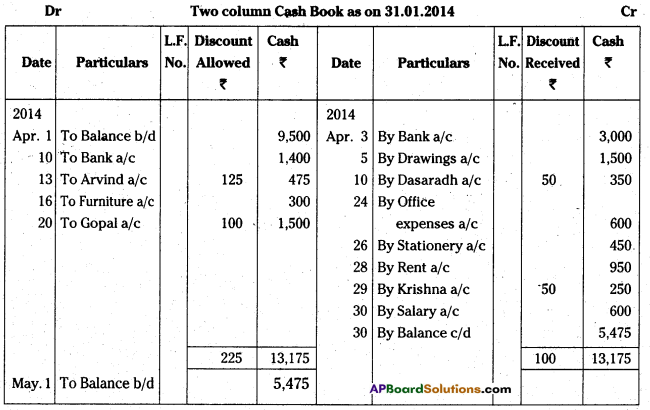
Question 6.
Prepare Double Column Cash Book from the following:
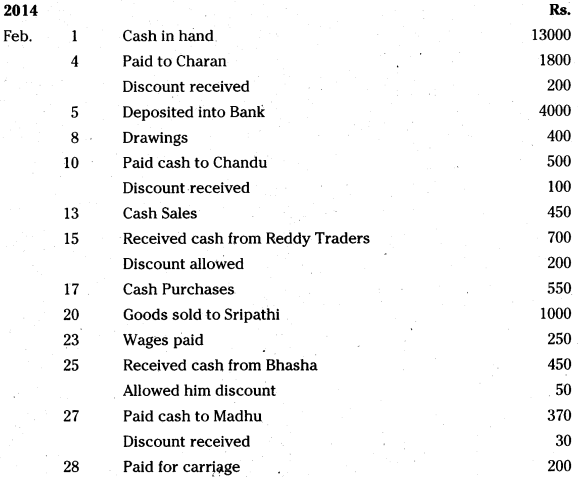
Answer:
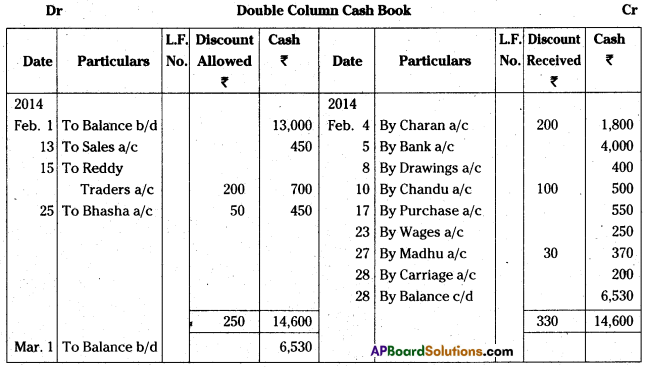
Hint: Transaction dated 20th is a credit Transaction.
Question 7.
Prepare Two column cash book with Bank and Discount columns from the following: (Mar. 17 T.S.)

Answer:
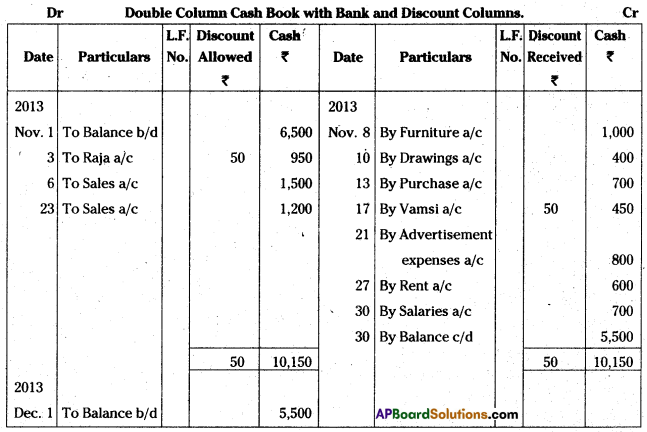
Question 8.
Prepare Three Column Cash Book. (Mar. 2019, ’17 – A.P.)
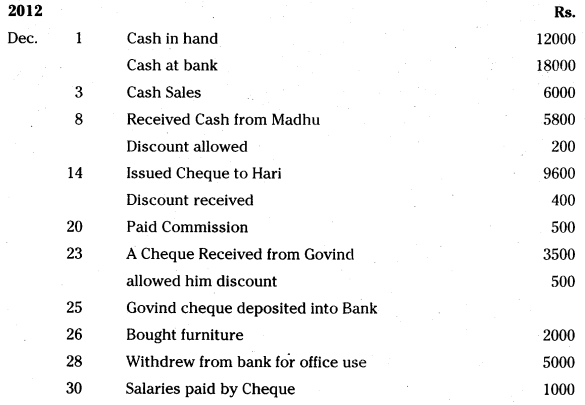
(Hint: Transactions dated 25th and 28th are Contra entries.)
Answer:
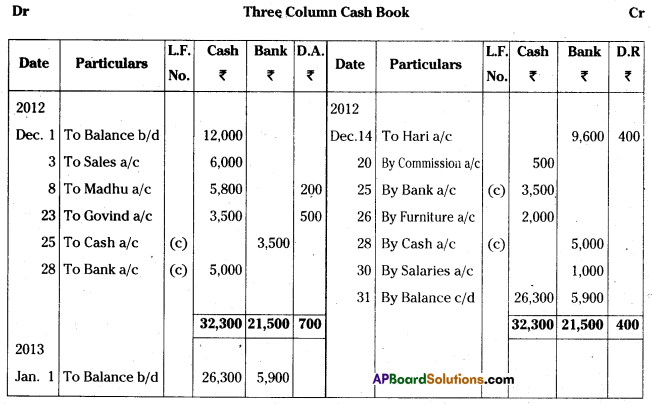
![]()
Question 9.
Prepare three column cash book from the following particulars :
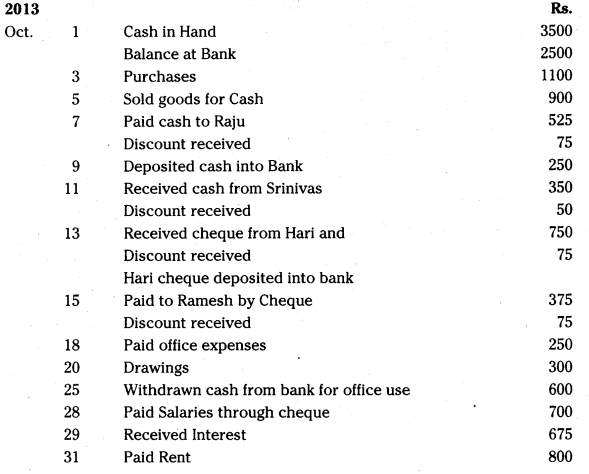
Answer:
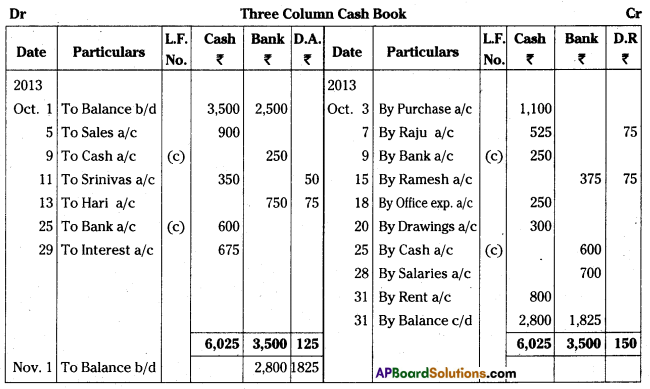
Question 10.
Prepare Triple Column Cash Book from the following:
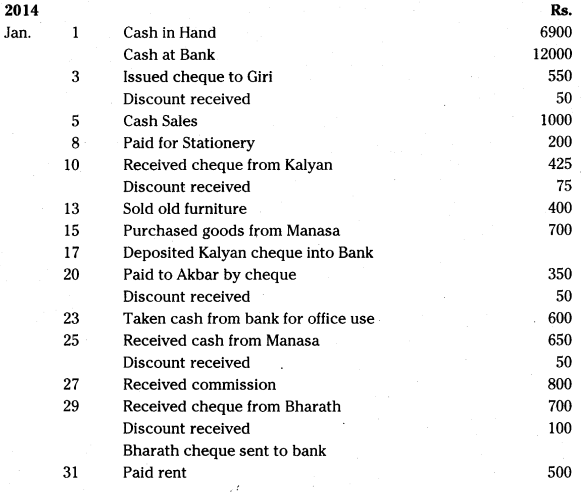
Answer:
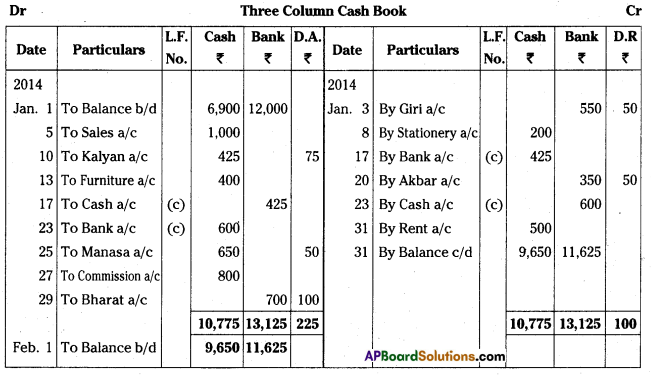
Question 11.
Record the following transactions in Cash, Bank, and Discount Columns Cash Book
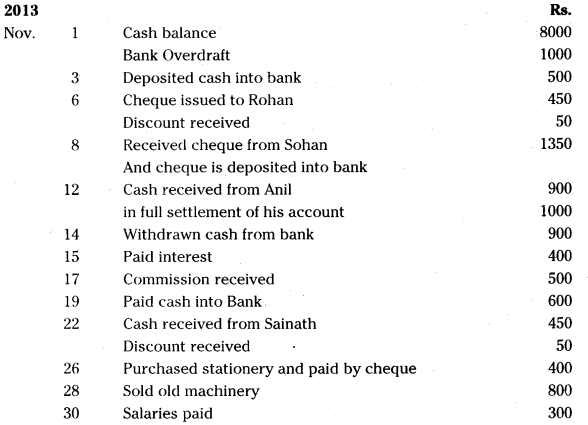
Answer:

Question 12.
From the following particulars, prepare three column cash book:

Answer:

Question 13.
Prepare triple column cash book from the following information, 2014 (May -17 – T.S.)
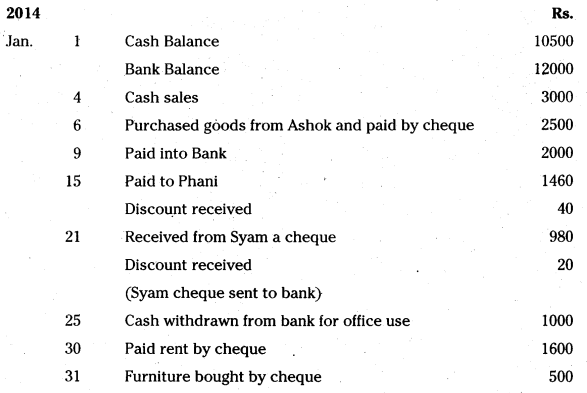
Answer:
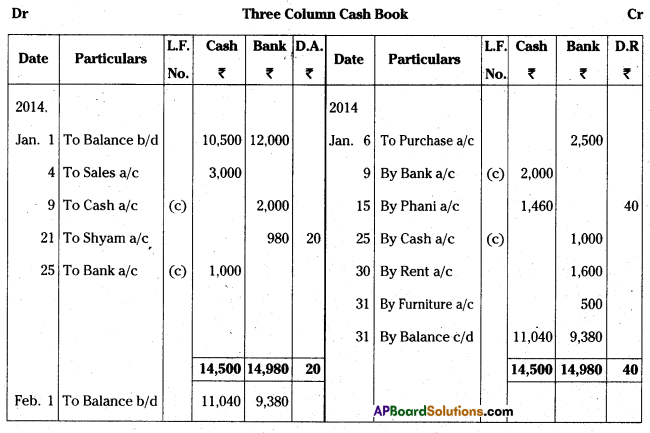
![]()
Question 14.
Prepare triple column cash book from the following particulars: (Mar. 2019, 18 – T.S.)
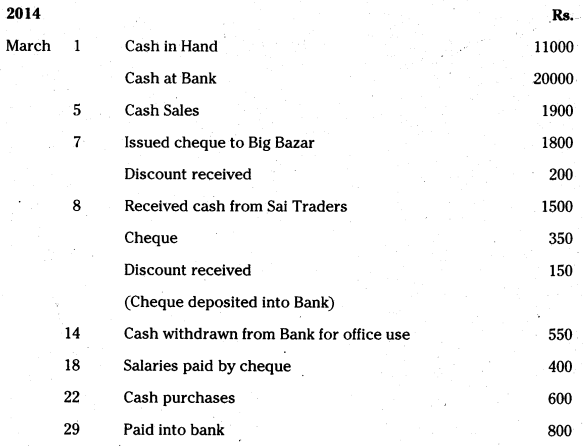
Answer:

Question 15.
Prepare Three Column Cash Book from the following: (Mar. 2018 – A.P.)
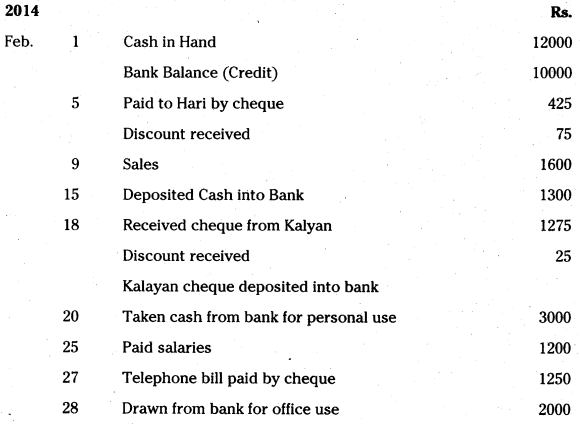
Answer:
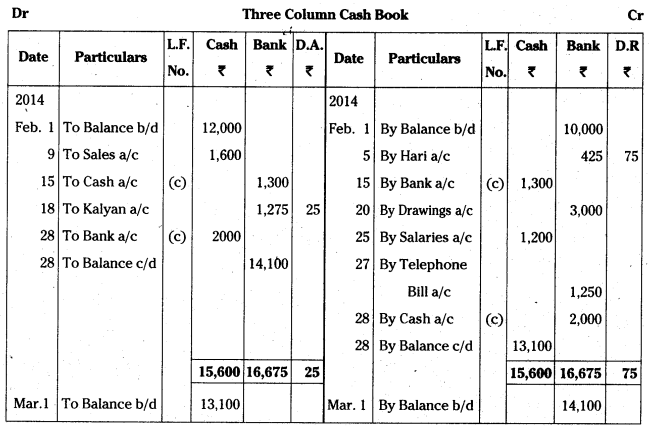
Question 16.
Prepare Three Column Cash Book from the following:

Answer:
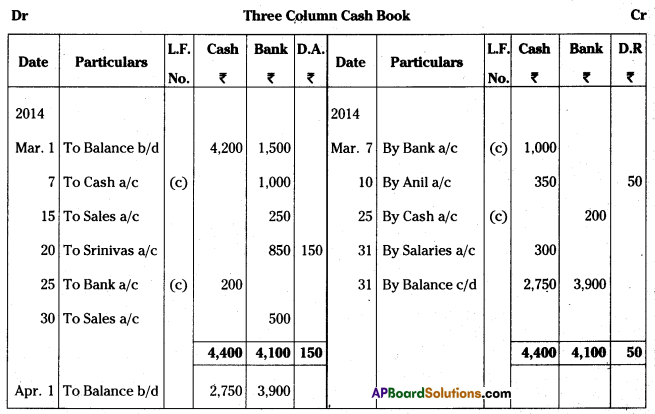
Question 17.
Prepare Three Column Cash book from the following particulars.
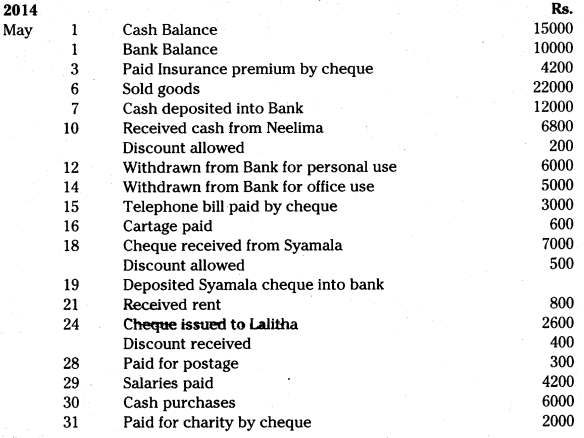
Answer:

![]()
Question 18.
Prepare Three Column Cash book of Mr.Stephen from the following particulars.
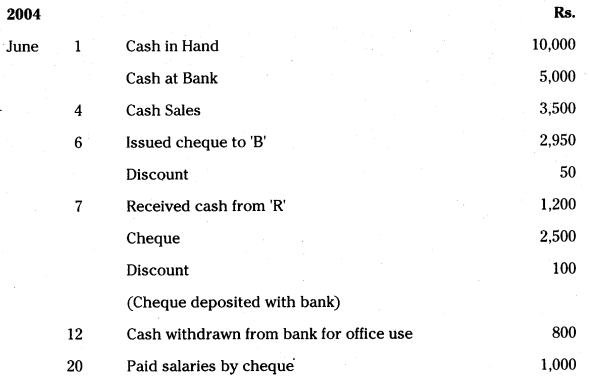
Answer:
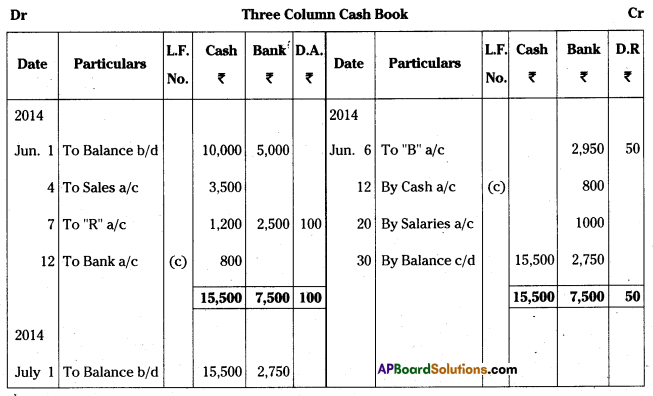
Question 19.
Prepare Three Column Cash book of Mrs. Vijaya from the following particulars 2010

Answer:
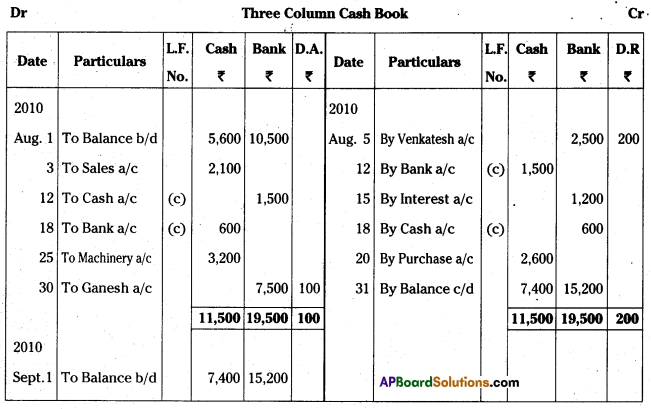
Question 20.
Prepare Analytical Petty Cash from the following particulars:
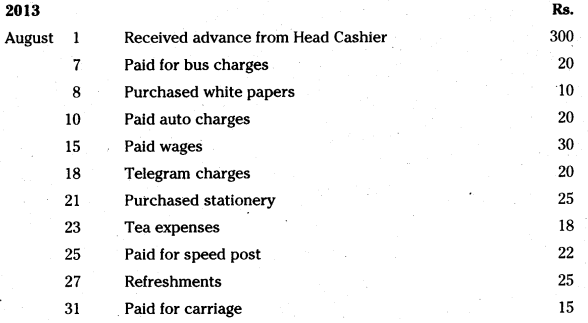
Answer:

Question 21.
Prepare Analytical Petty Cash Book.

Answer:
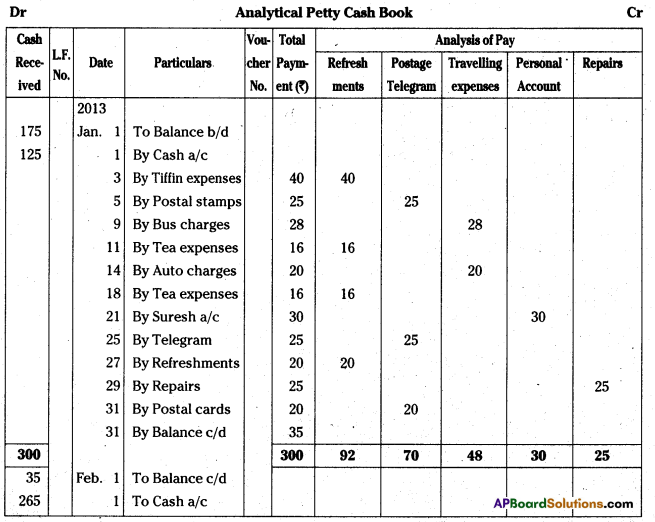
Question 22.
From the following information, prepare Analytical Petty Cash Book and also prepare ledger:

Answer:

Student Activity
- Collect Cash and Bank transactions during a month from any organisation or firm and prepare Cash Book.
- Collect daily expenses of small amount and prepare petty Cash Book.